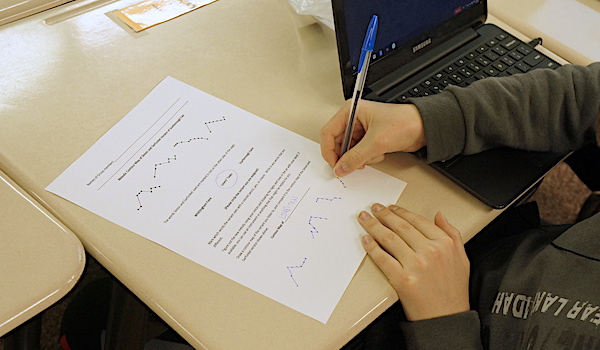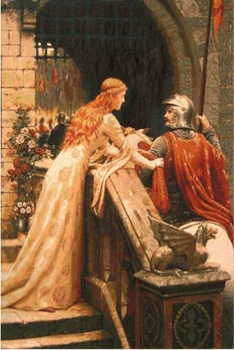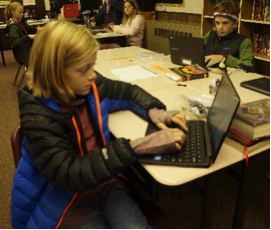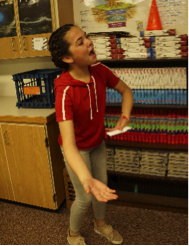SUBJECTS
GRADE
Show Results
The Elfin Knight

Lesson Summary
- Summarize the story found in “The Elfin Knight” after acting out lyrics.
- Understand the oral history of folk songs.
- Create a melodic contour map of a variant of “The Elfin Knight.”
Lesson Plan and Procedure
Lesson Key Facts
- Grade(s): 6
- Subject(s): Drama, English Language Arts, Music, Social Studies
- Duration of lesson: Two sessions, 45 minutes each
- Author(s): Emily Soderborg
Note: This is one of several lessons in a unit focused around the song “Scarborough Fair.” The unit introduces students to the Renaissance time period. Students should be familiar with the song “Scarborough Fair” (taught in the lesson “Introduction to Scarborough Fair”) before beginning this lesson. A PowerPoint presentation is included in the materials and equipment section as an option to use with the lesson.
Activity 1: The Lyrics
Project the painting “Godspeed, my knight,” by E. B. Leighton.
Teacher: As you look at this painting, what do you notice? What details stand out to you? What do you think this painting and the song “Scarborough Fair” have in common? What thoughts have you had about “Scarborough Fair” since learning the song? What do you think the lyrics might mean?
Read the following story description:
This song tells the tale of a young man who tells the listener to ask his former lover to perform for him a series of impossible tasks, adding that if she completes these tasks, he will take her back. Often the song is sung as a duet, with the woman then giving her lover a series of equally impossible tasks, promising to give him the things he has requested once he has finished his tasks.
The lyrics of "Scarborough Fair" appear to have something in common with a Scottish ballad, “The Elfin Knight,” which has been traced at least as far back as 1650, and very possibly earlier. The elf-knight blows a magic horn that makes any who hear its sound fall in love. A maid hears the horn and wishes out loud that she could marry the knight. Upon her speaking her wish, the knight appears, telling her he will marry her if she will perform numerous tasks, all impossible.
Teacher: Listen as I read the first task listed in the lyrics of “The Elfin Knight,” printed around 1670. See if you can figure out what the elf-knight is asking the maiden to do: “For thou must shape a sark to me, Without any cut or hem, quoth he.”
Use context clues and an online dictionary to help students figure out any words they do not know. A print dictionary might work, but some of the archaic words might not be in a print dictionary. Having students use individual Chromebooks would be ideal.

Teacher: Now that we know what the words mean, what do you think the elf-knight’s emotions were as he said these words? Some emotions to consider might be mischievous, smug, annoyed that he has to deal with a mere mortal, bored (looking for something to entertain himself), or another emotion I haven’t mentioned. Show me with your body and face what emotion you think the elf-knight is feeling, and freeze. If I tap you on your shoulder, tell the class what you think is going on in the elf-knight’s mind. This this called thought tracking; when I refer to this later, you will know what I mean.
Tap a student and listen as he or she shares what he or she thinks the elf-knight is thinking. Using thought tracking will help students explore their portrayed emotions a little deeper. Tap one, two, or three more students. (Their thoughts might sound something like this: “I don’t want to marry this maiden—I’m going to give her something impossible so she can never accomplish it,” or “I love playing tricks on humans! This is the third girl this week that I have left extremely confused!”)
Note: Using an emotion chart can help students get ideas for portraying characters. If students get stuck, you can refer them to the emotion chart for ideas. See additional resources for possible emotion charts to use.
Teacher: How do you think the maid responded when she was asked to do something impossible? What were her emotions? Some ideas to consider include love-struck, confused, overwhelmed, or frustrated. Show me with your body and face how you think the maiden feels. Ready? Freeze! When I tap your shoulder, be ready to share what you think the maiden is thinking in this situation.

Examples include “My head is spinning. I must be in love!” or “How am I ever going to be able to make a shirt for the elf-knight without cutting or sewing the fabric?” or “Perhaps if I think really hard, I’ll come up with an idea!”
Teacher: Now that we’ve done some thought tracking, let’s listen to the maid’s actual response. See if you can figure out what she is saying: “Now since ye've asked some things of me, It's right I ask as many of thee.”
Have students pair up and share their ideas of what the maid’s response means. Then ask a few students to share their ideas with the class.
Teacher: Did the emotions you showed for the maiden before match with what her response was? Now that you have this additional information, would you show the maiden’s emotions a different way? Show me with your body and face the emotion you think the maiden is feeling, and freeze.
Use thought tracking with the students. (Maybe you are thinking of ways you could get around the impossible task. Maybe you’re excited because you have an idea of how to complete the task.)
Teacher: Today we are going explore the rest of the lyrics for “The Elfin Knight” in pairs. You might notice that these lyrics are very similar to what we heard in “Scarborough Fair,” because “Scarborough Fair” is based on the story of “The Elfin Knight.” Through physical movement, gesture, and/or facial expression, figure out how to show the rest of the class what is being said in your verse, especially any unknown words and the emotions you think each character is feeling in your specific verse. You should say or, better yet, sing the lyrics as you perform. Your body language helps us understand what the lyrics mean, so the words and gestures are equally important. You can use the online dictionary if there are words in your verse that you do not know.
Divide students into pairs and give each pair a slip of paper with two lines from the lyrics of “The Elfin Knight” (each group will have a different set of lines from the lyrics). According to the number of students in your class, there might be more than one group with the same lines.
Give students a few minutes to work in pairs: looking up words, thinking of how to portray the characters’ emotions, creating ideas for their scenes, and rehearsing. There are several ways the students can present their lyrics to the rest of the class:
- One student in each pair can be the elf-knight, and one can be the maiden.
- Both students speak/sing the lyrics and show emotions together as the elf-knight or maiden.
- Both perform as the elf-knight and maiden and split up the lyrics. And then both show the emotions of the elf-knight and maiden.
Project all the lyrics for students to see, and have each group perform their scenes. Start from the beginning of the song, and work through each verse to the end, one group at a time. After each pair performs, they should freeze so the class can tap on their arms or shoulders to hear the inner thoughts of either the elf-knight, the maiden, or both. Some of the lyrics will be performed more than once. Take the opportunity to discuss differences in the separate groups’ performances of the same set of lyrics, and how personal interpretation changed the final performances.

Teacher: A ballad is a story told through a poem or song. What did you learn about the ballad “The Elfin Knight” by reading the lyrics, acting out a few lines, and watching other classmates act out the rest of the lines? How would you now summarize the storyline?
Have students pair up and summarize the storyline of the ballad. Then, call on one individual to share his or her summary with the class.
Compare and contrast the experience of hearing the Simon and Garfunkel version of “Scarborough Fair” to reading and acting out the story found in the lyrics.
Teacher: What did you notice when you listened to the song last time? Does “Scarborough Fair” tell the complete ballad of “The Elfin Knight?” What did you learn today as you read and acted out the lyrics of the ballad? How did the two experiences, listening and singing in the first lesson and reading and acting out the lyrics in this lesson, help you understand the song and time period better?
Assessment:
- Students can summarize the storyline of the ballad “The Elfin Knight.”
- Students can portray characters in the ballad through physical movement, gesture, and facial expression.
Activity 2: Variants
Teacher: How do you think people learned “The Elfin Knight” ballad when the song became popular during the Renaissance time period?
Give students an opportunity to share their ideas. Help them understand that music was passed down from person to person by singing or playing an instrument. During this time, music became a part of everyday life for the rich and poor. There was an incredible amount of music created.
Teacher: With the invention of the printing press, music began to be shared through broadsides. A broadside was a single sheet of printed paper. It often included a ballad, a rhyme, recent news, and sometimes even woodcut illustrations. Broadsides were one of the most common forms of printed material between the 1500s and the 1800s, particularly in Britain, Ireland, and North America, and were sold inexpensively. Generally, broadside ballads included only the lyrics of a song, often with the suggestion of a tune that the lyrics could fit with. If it was an unknown tune, people would learn the tune from the chapman (traveling salesman) who sold them the broadside. Because you had different people teaching the song, oftentimes many different versions of the same song were created. We call these different versions “variants.” Sometimes the melody changed with the different variants, sometimes the lyrics changed, and sometimes both things changed.

Teacher: There are many different versions of the ballad “The Elfin Knight”. “Scarborough Fair” is thought to be one of the variants, and it has many variants of its own as well. Today you are going to compare and contrast one of these variants with the Simon and Garfunkel version of “Scarborough Fair” we listened to previously.
Project the melodic contour map for students to see.
Melodic Contour Map of Simon and Garfunkel Version of "Scarborough Fair"

Teacher: A melodic contour map shows the highs and lows in each phrase of the melody. This map uses dots and lines to show the melodic contour.
Sing through the first verse of “Scarborough Fair,” and while singing, have everyone follow the map with their finger in the air to experience how a contour map works. After singing and following the map together on the board, hand out the “Scarborough Fair” variants comparison worksheet.
Teacher: This worksheet has a melodic contour map of the Simon and Garfunkel version of “Scarborough Fair” on one side and a version of the ballad’s lyrics on the other side. Simon and Garfunkel did not use all of the lyrics shown on this page. The lyrics they used are printed in red ink. The variants you listen to might not use all of the lyrics shown on the page, and they might even change the lyrics slightly from what is printed here. As you listen to your variant recording, use colored pencils, pens, or crayons to mark which lyrics are used, and write in any differences you hear in the recording from what is printed on the worksheet. Also, draw a melodic contour map to show the highs and lows of the melody, and compare it to the melodic contour map of the Simon and Garfunkel version of “Scarborough Fair.” As you work in your groups, you will need to listen to your recording several times and stop and start the recording frequently.
Break students up into small groups, about four or five students per group. Assign each group one of the three variants performed by Ensemble Phoenix Munich and Joel Frederiksen (“Whittingham Faire,” “The Lovers’ Tasks,” and “Scarborough Faire”). There might be multiple groups listening to the same variant.
Students will have 15 minutes to figure out the similarities and differences between their variant and the Simon and Garfunkel version. If possible, you could give them access to pitched instruments (barred instruments, boom whackers, a piano, or even a digital keyboard online) to help them. Each group will need a device to listen to their variant. This could be a CD player, an iPad, a Chromebook, an iPod with speakers, or any other available classroom resources.



Give students time to work in groups. Then gather them and discuss as a class what they discovered.
Teacher: Since there are so many versions, why do you think we sing one version more than all the others now?
Teacher: Historically, folk music comes from an oral tradition, meaning it was passed from singer to singer, but the 1900s brought technology and recordings. Since the invention of recording technology, music is no longer passed down by singers, but by recordings, and the recordings we have don’t change. There are lots of recordings of different variants, but Simon and Garfunkel’s recording is the most famous, so the melody and words they sang are the ones most people are familiar with.
Assessment
- Students can sing the melody and words to “Scarborough Fair.”
- Students can create a melodic contour map of a variant of “The Elfin Knight” and mark which words are used in the variant.
Learning Objectives
- Identify how civilizations created technologies and systems to meet community and personal needs, specifically the evolution and importance of writing.
- Give evidence of understanding of the transformation of cultures during the Middle Ages and the Renaissance and the impact of this transformation on modern times.
- Listen for and identify the melody in a song, and respond to visual representations of melodic patterns.
- Identify the possible intent of a music selection and how music elements are used to convey it.
- Deepen understanding of another content area through music.
- Experience and explore music which connects us to history, culture, heritage, and community.
- Determine the meaning of words and phrases as they are used in a text, including figurative and connotative meanings.
- Compare and contrast the experience of reading a text to listening to or viewing an audio recording, video, or live version of the text, including contrasting what they “see” and “hear” when reading the text to what they perceive when they listen to or watch it.
- Create characters through imagination, physical movement, gesture, sound and/or speech, and facial expression.
Utah State Board of Education Standards
This lesson can be used to meet standards in many grades and subject areas. We will highlight one grade’s standards to give an example of application.
Grade 6 Social Studies
- Standard 6.1.1: Discern characteristics needed for the transformation from simple societies to civilizations, and compare those characteristics in at least three different ancient civilizations found in different regions of the world.
- Standard 6.1.4: Identify some of the economic systems and technologies (for example, irrigation, writing systems, farming techniques, trading and bartering, coins and currency) created by three civilizations found in different regions of the world, and categorize how they met specific human needs or wants.
- Standard 6.1.5: Use primary and secondary sources to compare the cultures of three civilizations found in different regions of the world and identify examples of cultural expression (for example, architecture, writing, philosophy, artwork).
- Standard 6.2.3: Identify the most historically significant inventions and innovations from Ca. 500 C.E.–1500 C.E. (for example, printing press/moveable type, astronomy, medicine), and argue their ongoing importance.
Grade 6 Music
- Standard 6.M.P.5: Respond to visual representations of melodic patterns using pentatonic, major, and minor scales.
- Standard 6.M.R.2: Listen for and identify form, meter, rhythm, timbre, dynamics, tempo, melody, texture, and harmony/tonality.
- Standard 6.M.R.4: Describe feelings or imagery conveyed by a music selection.
- Standard 6.M.R.5: Identify possible intent of a music selection, and how the music elements are used to convey it.
- Standard 6.M.CO.2: Draw upon interests, knowledge, and skills developed to inspire and inform the creation, performance, and appreciation of music, and deepen understanding of another content area through music.
- Standard 6.M.CO.3: Experience and explore music which connects us to history, culture, heritage, and community; identify connections between a music genre and cultural or historical contexts; and explore and explain how musical works are influenced by a composer’s heritage and experiences.
Grade 6 English Language Arts
- Standard 6.R.5: Cite textual evidence to support analysis of what the text says explicitly as well as inferences drawn from the text. (RL & RI)
- Standard 6.R.6: When reading texts, including those from diverse cultures, determine the theme, how characters respond to conflict or how the speaker reflects upon a topic, and summarize the text. (RL)
- Standard 6.R.8: Determine the meaning of words and phrases, including figurative language, connotative meanings, and figures of speech. Analyze the impact of specific word choices on meaning and tone, including words with multiple meanings within a text. (RL & RI)
- Standard 6.R.12: Compare how different mediums, including print and digital media, contribute to the understanding of a text. (RL & RI)
- Standard 6.SL.2: Interpret credible information presented in various formats and media to make informed decisions.
- Standard 6.R.9: Determine or clarify the meaning of unknown and multiple-meaning words and phrases, choosing flexibly from a range of strategies. (RL & RI)
- Consistently use context as a clue to the meaning of a word or phrase
- Consult reference materials to find the pronunciation of a word or determine its precise meaning or its part of speech.
Grade 6 Drama
- Standard 6.T.CR.2: Arrange the physical playing space to communicate mood, time, and locale.
- Standard 6.T.CR.3: Write or record simple dramas that include the five Ws of who, what, where when and why.
- Standard 6.T.CR.4: Define roles, identify responsibilities, and participate in group decision making.
- Standard 6.T.CR.5: Create characters through imagination, physical movement, gesture, sound and/or speech and facial expression.
Equipment and Materials Needed
- PowerPoint presentation (optional)
- Projector
- Projection of the painting “Godspeed, my knight” by E. B. Leighton
- Lyrics of “The Elfin Knight” printed and cut up into single verses for student partnerships
- Online English dictionary that has archaic English definitions (https://en.oxforddictionaries.com/)
- Six devices to listen to variants--one in each group (CD player, iPad, Chromebook, iPod with speakers, or other classroom resources)
- “Scarborough Fair” variants comparison worksheet
- Colored pencils, pens, or crayons
- Pitched instruments to help students figure out variant melodies (optional)
- Three recordings of variants of “The Elfin Knight” by Ensemble Phoenix Munich and Joel Frederiksen on the album “The Elfin Knight” Ballads and Dances
- “Whittingham Faire”
- “The Lovers’ Tasks”
- “Scarborough Faire”
Additional Resources
- This is one of several lessons that create a unit focused around the song “Scarborough Fair” to introduce various aspects of the Renaissance time period. The other lessons in the unit include the following:
- The Child Ballads are 305 traditional ballads from England and Scotland and their American variants, anthologized by Francis James Child. The following website has 17 different variant texts for “The Elfin Knight” collected by Child. Child was among the first to consider these ballads an important part of early English literature—right alongside the works of Geoffrey Chaucer and Edmund Spenser. http://www.springthyme.co.uk/ballads/balladtexts/2_ElfinKnight.html
- https://www.npr.org/2013/04/20/177997065/not-for-kids-these-child-ballads-are-steeped-in-history
- Emotion Charts
Image References
Image 1: Emily Soderborg.
Image 2: https://en.wikipedia.org/wiki/God_Speed_(painting)#/media/File:Leighton-God_Speed!.jpg
Image 3–5: Brenda Beyal.
Image 6: https://commons.wikimedia.org/wiki/File:A_lamentable_ballad_of_the_little_Musgrove,_and_the_lady_Barnet.png
Image 7–10: Emily Soderborg.

www.education.byu.edu/arts/lessons
 Download
Download